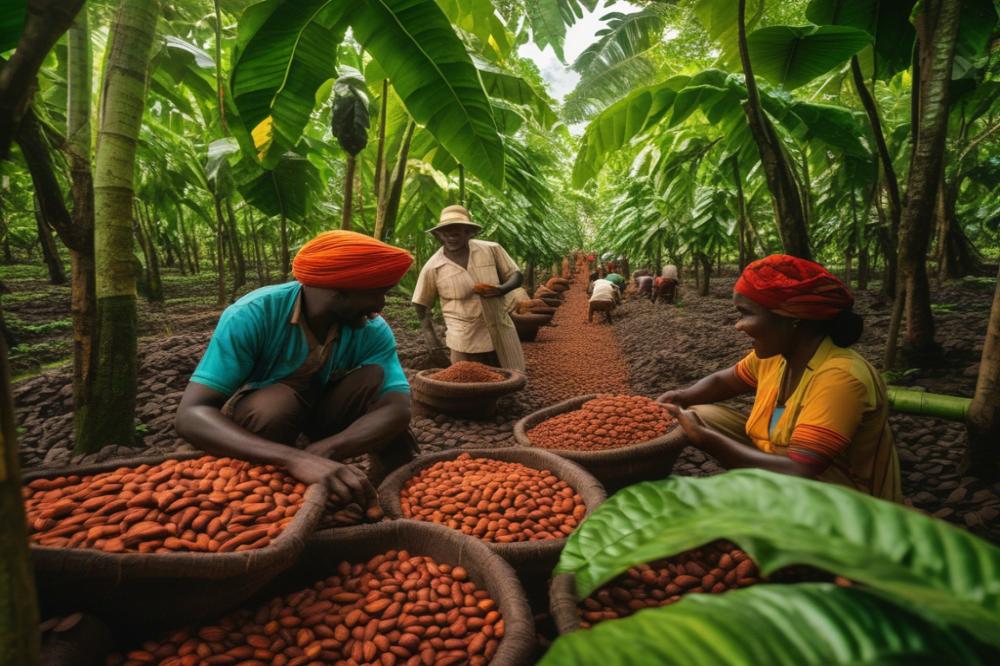Overview of Chocolate Industry Trends and Innovations
Chocolate is more than a sweet treat; it’s a world of flavors, cultures, and connections. As consumers become more interested in where their food comes from, trends in the industry are shifting. People appreciate not just the taste but also the story behind the chocolate. Innovations are emerging in production methods, with a focus on quality, sustainability, and ethics. Many brands have moved towards bean-to-bar production, which allows for better control over the entire chocolate making process.
The Significance of hyperlocal cocoa sourcing

At the heart of these developments is the idea of hyperlocal cocoa sourcing. This concept highlights getting cacao beans from nearby regions instead of relying on distant suppliers. Sourcing locally helps artisans connect with farmers and strengthen community ties. Local farmers can share their expertise on growing regional varieties. Such collaboration enriches flavor profiles and leads to more diverse chocolate experiences. Consumers enjoy the idea that their chocolate supports nearby economies while promoting food transparency. This connection fosters a sense of trust and loyalty, as buyers can see the positive impact on the local cacao community.
Connection to Sustainability and Ethical Practices

sustainable sourcing and direct trade are becoming essential in the chocolate industry. Many consumers are drawn to brands that prioritize eco-friendly practices. These efforts go hand-in-hand with the movement towards hyperlocal cocoa sourcing. By working directly with local farmers, chocolatiers can ensure better wages and working conditions. This approach not only benefits the farmers but also enhances the quality of the cacao. The emphasis on ethical practices adds value to artisanal chocolate, as it reflects a commitment to quality over quantity. With each bite, consumers savor not just delicious chocolate but the profound impact of their choices on the environment and communities.
In a world craving authentic experiences, these trends mark a significant change in how chocolate is produced and appreciated. The future of chocolate making is rooted deeply in local traditions, ethical decisions, and a commitment to sustainability.
Understanding Hyperlocal Cocoa Sourcing

Hyperlocal cocoa sourcing refers to the practice of obtaining cocoa beans from nearby farms. This approach focuses on the local community, emphasizing direct trade between chocolate makers and farmers. It contrasts sharply with traditional methods, where beans often travel long distances from various countries. Such distance can mask the true origin of the cocoa and limit the connection between producers and consumers.
Definition and Principles of Hyperlocal Cocoa Sourcing
The essence of this method lies in building relationships. Artisanal chocolate makers seek out local farmers to establish meaningful partnerships. These connections promote sustainable sourcing and highlight the importance of food transparency. By working closely with farms, chocolate producers can showcase regional varieties that contribute to unique flavor profiles. This idea not only helps the environment but also supports economic growth.
Comparison with Traditional Cocoa Sourcing Methods
Traditional cocoa sourcing often relies on large, industrial supply chains. This process can be impersonal and detached. Chocolate makers might not know where their beans originate or the conditions under which they were grown. In contrast, a hyperlocal approach fosters a more personal relationship with farmers. This connection can lead to better quality beans and a more refined end product.
Impact on Local Economies and Farmers
Local farmers benefit significantly from this sourcing strategy. Direct trade models allow them to earn fair wages for their labor. When local economies thrive, communities flourish. Chocolate makers invest directly in their regions, creating a supportive cacao community. They promote eco-friendly practices as well, often adopting methods that benefit both the land and the people who live on it.
Furthermore, this approach empowers farmers to share their knowledge about growing practices. Those details can lead to improvements in crop quality and harvest size. As a result, chocolate makers gain beans that enhance the flavor of their products. The collaboration promotes greater diversity in cocoa types and cultivates a market for premium, high-quality chocolate.
Overall, hyperlocal cocoa sourcing creates a win-win situation for everyone involved. Consumers enjoy better taste while supporting sustainable farming practices. The growing trend continues to change the chocolate landscape, enriching both the industry and the environment.
Sustainable Sourcing and Its Impact
Exploring sustainable sourcing practices is essential in chocolate making today. Many producers are realizing the importance of connecting with local farmers. This approach leads to better quality cacao beans, which directly enhances flavor profiles in the final product.
Benefits arise from sourcing cacao hyperlocally. By purchasing directly from farmers, chocolate makers can foster a strong relationship with their cacao community. Such relationships often lead to transparency in food production. Consumers, in turn, can trust that their artisanal chocolate is made from high-quality ingredients.
Direct trade practices also help prioritize environmental stewardship. Farmers who adhere to eco-friendly practices often use methods that avoid harmful chemicals. These practices positively impact local ecosystems. Healthier plants contribute to a richer soil, supporting a diverse range of regional varieties.
The bean-to-bar movement further enhances the significance of sustainable sourcing. Chocolate makers are focused on crafting high-quality products from start to finish. They pay attention to the entire process, benefiting farmers and consumers alike. In this way, artists at every level create delicious and mindful chocolate.
Adopting hyperlocal sourcing has a ripple effect on sustainability as well. The local economy sees improvements, which leads to stronger communities. This growing trend supports farms while reducing carbon footprints associated with long-distance shipping. Ultimately, chocolate lovers enjoy flavors that truly reflect their region.
Emphasizing these practices creates a chain of responsibility. It assures that every bite delivers not just joy, but also supports sustainable efforts. Today’s chocolate makers can transform the industry by staying committed to these eco-friendly methods.
Direct Trade and Relationship with Local Farmers
Direct trade is essential for hyperlocal cocoa sourcing. It creates a bridge between chocolatiers and local farmers. This connection gives farmers more control over their products. Chocolatiers can discover how cacao is grown and harvested. Knowledge of cultivation methods leads to better flavor profiles in chocolate. Making this connection helps ensure that the chocolate stands out.
Building relationships with local farmers fosters community ties. These connections allow farmers to share their unique stories and traditions. When chocolatiers work closely with them, they learn about regional varieties. This not only enriches the chocolate-making process but also celebrates the diverse profiles of cacao. Trust naturally develops over time, benefiting both parties.
Fair compensation plays a vital role in this relationship. Paying farmers a reasonable price for their work empowers them. Educating farmers about eco-friendly practices helps improve their yields. With this knowledge, they can produce better beans while also caring for the environment. This commitment strengthens the entire cacao community and supports sustainable sourcing.
Local farmers often have special knowledge about their land. This understanding can lead to the discovery of artisanal chocolate that stands apart from mass-produced options. Each batch of cacao tells its own story, thanks to these dedicated growers. Consumers deeply appreciate this food transparency. They want to know where their chocolate comes from and how it is made.
Through direct trade, chocolatiers can create a more responsible supply chain. This practice not only influences flavor but also the ethical impact of chocolate production. Supporting local farmers leads to a ripple of positive effects. Taste and sustainability go hand in hand when the relationship between farmer and maker thrives.
Flavor Profiles and Regional Varieties
Hyperlocal sourcing has changed the way we think about chocolate. Flavor profiles are now more diverse than ever. Different regions produce cocoa that offers distinct flavors. For instance, beans from Ecuador may taste fruity, while those from Madagascar can have citrus notes. This variety comes from local climate, soil, and traditional farming methods. The process of chocolate making is now deeply tied to where the beans are grown.
Exploring regional varieties helps chocolatiers create more than just sweet treats. Each location has its own character, rich history, and community. Local farmers bring their expertise to the table, emphasizing the importance of sustainable sourcing. When makers purchase directly from farmers, they tell a story with each bar of chocolate. This connection deepens the bond between the cacao community and chocolate lovers.
The bean-to-bar movement has made waves in the chocolate industry. Artisanal chocolate makers focus on quality over quantity. They seek to highlight the nuances of different cocoa varieties. This shift enhances food transparency, allowing consumers to understand what they are eating. With more people asking questions about where their chocolate comes from, the industry is responding positively. Eco-friendly practices are becoming standard, influenced by the desire for authenticity in the process.
As we explore the world of chocolate, the impact of sourcing becomes clear. Lovers of chocolate can taste the difference when they choose smaller brands. These brands are often committed to direct trade and fair compensation for farmers. Therefore, each bite of chocolate becomes a celebration of the place it originated from. Shifting focus to regional varieties cultivates appreciation among consumers for the artistry involved in making chocolate. It’s about more than just the taste; it’s an experience that connects people across different regions.
Cacao Community and Food Transparency
The role of the cacao community in hyperlocal sourcing
The cacao community plays a vital role in sourcing cocoa locally. They connect farmers directly with chocolate makers. By cutting out middlemen, local farmers receive better wages. This model promotes sustainable sourcing and helps communities thrive. Supporting local farms fosters a sense of belonging. Everyone reaps the benefits from fair trade practices to improved livelihoods. Chocolate makers can experiment with regional varieties that are often overlooked.
Enhancing food transparency and consumer trust
Food transparency matters more than ever. Consumers want to know where their chocolate comes from. By sharing the origins of cacao, brands build trust. When customers understand the journey of their chocolate, they feel more connected. The clear labeling of ingredients and sourcing practices is crucial. Actions such as showcasing direct trade relationships instill confidence in products. This trust motivates consumers to choose chocolate that aligns with their values.
Importance of storytelling in artisanal chocolate making
Storytelling adds depth to chocolate making. Each bar carries a narrative that reflects its roots. Artisanal chocolate makers highlight the flavors tied to specific regions and farming practices. By sharing these stories, they engage consumers on a personal level. Flavor profiles become a gateway to understanding culture and tradition. When people hear about the farmers who grew the cocoa, their appreciation deepens. This connection can turn ordinary chocolate into something special. Eco-friendly practices also enhance the story, showing commitment to the planet.
Engaging with the cacao community is not just about chocolate. It’s about creating a network of trust and respect. Personal stories and shared experiences matter. Together, these elements contribute to a healthier relationship between consumers and the cacao community.
Wrapping It Up: The Shift Towards Local Cocoa
In summary, the trend of sourcing cocoa locally is shaping the future of chocolate making. This approach fuels a connection between producers and consumers, bringing their stories to life in each bite. By focusing on local farms, chocolate makers are not just enhancing flavors; they are also building a more ethical supply chain.
Looking ahead, the impact of this practice will likely grow. More brands will adopt sustainable sourcing strategies that highlight ingredients’ origins. Community engagement will continue to rise, drawing consumers closer to the people who cultivate their treats. As awareness increases, shoppers will seek options that embrace both quality and ethical standards. The rise of direct trade relationships can further strengthen this bond, fostering transparency in production.
Every individual can play a part in this movement. By choosing to support brands that prioritize local sourcing, consumers help protect the environment and promote fair labor practices. Enjoying chocolate shouldn’t just be about taste; it should resonate with principles of justice and sustainability. The next time you indulge in a chocolate bar, remember that your choice can support a brighter future for farmers. Together, let’s celebrate buying chocolate that is both delicious and responsible.



